
A smooth patch of grass is nice, but compared to a yard filled with native wild flowers, blooming bushes, and shade trees, there is really no comparison. The ‘well manicured lawn’ requires more water and nutrients than the native landscape, which brings us to BMAPS.
Irrigation and fertilization of our landscapes impacts our aquifer and springs. The Basin Management Action Plan (BMAP) is intended to restore our impaired springs by reducing the nutrient overuse that leads to algae growth. Reducing over-pumping that weakens our spring flow is also part of the plan. Too many lawns, too many fertilizers, we only have the one aquifer.
The transition to the no mow yard is a worthy ambition. If the concept seems daunting, begin in patches, and let those patches expand. Soon, you too will experience the freedom and beauty of a no-mow yard.
Santa Fe River, Inc. supports a no mow, native landscaping that requires little to no irrigation and fertilizer. Native beauty bushes surrounded by islands of coreopsis, shaded by a buck-eye is eye catching and nourishing to birds and pollinators. Here is our link to Aquifer Friendly Landscaping.
Below is a blog published by the The Alachua County Library District called No Mow May. Please ignore the part about IFAS guidelines, which endorses fertilizer use and irrigation which does not go far enough to protect our waters. The alternative ground-cover ideas are great though, and the book recommendations inspiring. We can all agree that we need to adapt our old landscaping ways to protect our precious resource: water.
OSFR President Joanne Tremblay
joanne.tremblay@oursantaferiver.org
“Giving Our River A Voice”
No Mow May

What is No Mow May?
No Mow May was started by the British conservation charity Plantlife in 2019. This campaign encourages home, business, and land owners to not mow their lawns in May—and mow less in the summer—to help wildflowers flourish and give local pollinators like bees and other insects a chance to do their important work.
Participation in No Mow May is easy. Don’t mow your lawn all May! During the summer, you can choose not to mow some or all of your green spaces. Allow for patches of wildflowers to grow and watch as they provide vital food for pollinators.
What is a No Mow Lawn?
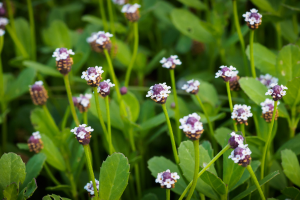
If you aren’t a fan of mowing, especially in the Florida heat, consider creating a No Mow Lawn.
According to UF/IFAS, there are a few ways to create a No Mow Lawn. You can replace turfgrass in all or part of your yard with an alternative lawn, a wildflower lawn, a landscape with groundcovers, trees, and shrubs, or just expand existing flowerbeds.
Some lower-maintenance, Florida-native, and Florida-friendly alternatives to turfgrass lawns include yards planted with Perennial Peanut (Arachis glabrata), Sunshine Mimosa (Mimosa strigillosa), Frogfruit/Fogfruit (Phyla nodiflora), Basketgrass (Oplismenus setaruis), Asiatic Jasmine (Trachelospermum asiaticum), Twinflower (Dyschoriste oblongifolia), or a mix of species in the same lawn like white clover, oakleaf fleabane, and lyre-leaved sage.
If your goal is to create a section of No Mow landscaping with flowers and shrubs in your yard, try Black-eyed Susan (Rudbeckia hirta), false rosemary (Conradina canescens), flax lily (Dianella tasmanica), dwarf yaupon holly (Ilex vomitoria), and redbud trees (Cercis canadensis).
UF/IFAS has more ways to create a Florida-friendly lawn with their Florida-Friendly Landscaping Program which includes guides on water efficiency, attracting wildlife, managing yard pests, and more.
Neighbor, meet Pollinator
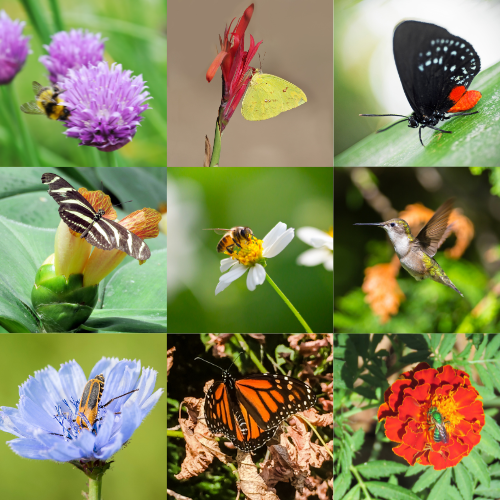
Hey neighbor! Are you familiar with your native pollinators who would benefit from No Mow May here in North Central Florida? If not, here is a list of a few in our area.
You can also learn about native pollinators at our Insect Pollinators in Florida Gardens event on May 26 at 2 p.m. at the Millhopper Branch. Join the Gainesville Bromeliad Society to learn how to care for bromeliads and attract pollinators to your yard.
Make a Wild Bee Hotel in Homeschool MakerSpace on May 16 at 11 a.m. at the Archer Branch. Build a safe, snug shelter for our buzzy pollinator friends to attract them to your garden!
Bumble bees — There are over 250 subspecies of bumble bees, but there are only five in Florida: common eastern (Bombus impatiens), two-spotted (B. bimaculatus), brown-belted (B. griseocollis), American (B. pennsylvanicus) and southern plains (B. fraternus).
Cloudless sulphur — Cloudless sulfur can be found year-round in the southern United States and they migrate to the Gainesville area.
Atala — The Atala is the largest hairstreak in Southeast Floridia and was once thought to be extinct. It has made a comeback thanks to the popularity of its host plant—the coontie palm (Zamia integrifolia)— in landscaping.
Zebra longwing — Meet Florida’s official state butterfly! They can be found in gardens throughout the state and frequently roost in groups of up to 60 individual butterflies.
Leafcutter bees — There are about 75 species of Leafcutter, or Megachilidae, bees and they are solitary nesters. The most commonly spotted of these are those in genus Megachile, Osmia, and Coelioxys.
Ruby-throated hummingbird — Yes, this little bird is a pollinator too! They are the most common hummingbird found in Florida. These migrating birds can be found in Florida from March to October with males arriving first followed by the females a couple of weeks later.
Goldenrod soldier beetle — Goldenrod solider beetles can be found throughout most of the United States, including Florida. They feed on nectar and pollen as well as garden pests like aphids, caterpillars, and other insect eggs.
Viceroy — These Monarch butterfly look-alikes can be found in Florida and prefer wet habitats like ponds, rivers, and swamps where their host plants grow. In Florida, they tend to be more reddish-brown, mimicking Queen and Soldier butterflies more than Monarchs.
Sweat bees — There are over 60 species of sweat bees in Florida. They nest in the ground and are important pollinators of wildflowers and crop plants like stones fruits, sunflowers, and alfalfa.
Some Garden Reading
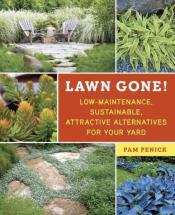
Lawn Gone!: Low-Maintenance, Sustainable, Attractive Alternatives for Your Yard by Pam Penick
A colorful guide covering the basics of replacing a traditional lawn with a wide variety of easy-care, no-mow, drought-tolerant, money-saving options that will appeal to today’s busy, eco-conscious homeowner.
Lawn Gone! is an essential guide to low-water, easy-care lawn alternatives for beginning gardeners and anyone concerned about the environmental costs of maintaining a lawn. Filled with how-to information, design ideas, and inspirational photographs, it covers all the available options: alternative lawns, ornamental grasses, groundcovering plants, small shrubs and perennials, artificial turf, “people places” like patios and paths, and more. In addition, it includes step-by-step lawn-removal methods, strategies for dealing with HOAs and lawn-loving neighbors, and practical ways to reduce your lawn if you’re not ready to go all the way. Written by Austin garden designer and award-winning blogger Pam Penick, Lawn Gone! will show you how easy it is to ditch the lawn and create an enjoyable, earth-friendly landscape for your home.
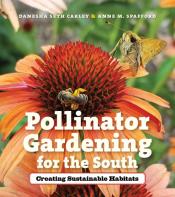
Pollinator Gardening for the South: Creating Sustainable Habitats by Danesha Seth Carley
This step-by-step guide will answer all of your questions about how to create beautiful gardens designed to welcome beneficial pollinators across the South. Combining up-to-date scientific information with artful design strategies, Danesha Seth Carley and Anne M. Spafford teach gardeners of all levels to plan, plant, and maintain successful pollinator gardens at home and in shared community sites. Everyday gardeners, along with farmers, scientists, and policymakers, share serious concerns about ongoing declines in bee and other pollinator populations, and here Spafford and Carley deliver great news: every thoughtfully designed garden, no matter how small, can play a huge role in providing the habitat, nourishment, and nesting places so needed by pollinators. This book explains all you need to be a pollinator champion.
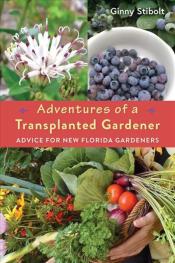
Adventures of a Transplanted Gardener: Advice for New Florida Gardeners by Ginny Stibolt
A starter guide to cultivating plants that flourish in Florida.
Ideal for gardeners new to Florida and residents who want to try their hands at gardening for the first time, this starter guide helps readers learn to grow plants in the state’s unique natural environment. Botanist and lifelong gardener Ginny Stibolt shares helpful stories, advice, and tips from her own experience moving to Florida, where she discovered that the rules she had followed for years did not apply.
Stibolt tells her readers what they can do to avoid the beginner mistakes she made and dispels common misconceptions about which plants to grow and how to grow them in Florida. Introducing Florida’s water features, natural areas, and native plant communities, Stibolt shows what a “Real Florida” landscape looks like and explains how working with this knowledge makes gardening easier and more successful. She explores useful topics including gardening for birds and butterflies, growing food, composting, and stormwater management. Stibolt also points to resources for digging deeper into these and related subjects based on the reader’s needs and location within the state.Full of friendly, reliable, and commonsense expertise, Adventures of a Transplanted Gardener sets aspiring growers on the fast track to cultivating plants that flourish in Florida. This book is the perfect resource for anyone interested in the challenges, rewards, and beauty of gardening in the Sunshine State.
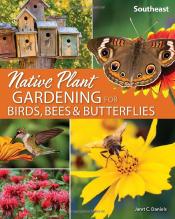
Native Plant Gardening for Birds, Bees & Butterflies: Southeast by Jaret C. Daniels
The presence of birds, bees, and butterflies suggests a healthy, earth-friendly place. These most welcome guests also bring joy to those who appreciate watching them. Now, you can turn your yard into a perfect habitat that attracts them and, more importantly, helps them thrive. Acclaimed author and expert entomologist Jaret C. Daniels provides all the information you need in this must-have guide for northern Florida, Georgia, Kentucky, North Carolina, South Carolina, Tennessee, Virginia, and West Virginia. You can learn how to landscape and create pollinator gardens with native plants.
The book begins with an in-depth introduction to native pollinators and to birds. It’s followed by a “field guide” section to 100 native plants that are widely available to utilize, are easy to care for, and provide great benefit to birds, bees, and butterflies. The species are organized by level of sunlight needed and then by plant types. Each species includes full-color photographs and information about hardiness zones, what they are most likely to attract, soil requirements, light levels, and Jaret’s notes. As an added bonus, you’ll make use of blooming charts, tips on attracting specific species, and more! Plus, the invaluable garden plans and projects show you just what to do and can be customized to suit your own specific interests.
Plan, plant, and grow your own beautiful garden, with native plants that benefit your favorite creatures to watch and enjoy.
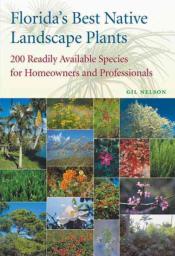
Florida’s Best Native Landscape Plants: 200 Readily Available Species for Homeowners and Professionals by Gil Nelson
Florida’s Best Native Landscape Plants is an illustrated guide for landscape designers, home gardeners, and restoration professionals. Published in cooperation with the Association of Florida Native Plant Nurseries and the Florida Department of Transportation, it provides technical information on the design and maintenance of native plants that are readily available from the state’s native plant nurseries for use in Florida gardening and landscaping. The 200 species were selected for their availability and for their general hardiness, popularity, and ease of use in both commercial and residential landscapes. All are easily found in the native plant trade and will perform well in both home and commercial landscapes.
Each species profile details size and form, uses for landscaping and/or gardening, best features, range and distribution, physical appearance, culture, best companion plants, allergenic properties, cultivars, and similar species. Each account is illustrated with one or more color photos, over 700 in all, and 180 of them are further illustrated with an original watercolor. An introductory section introduces readers to the importance and benefits of using native plants in landscaping.
Both federal and state guidelines mandate the incorporation of regional native plants in public site design to the maximum extent possible. Gil Nelson’s book provides information for those charged with selecting easy-to-obtain native species for use in state and local parks and along our highways—and assists planners and designers, architects, and homeowners in making educated decisions about native plant selection and use.
Gil Nelson is a writer, naturalist, and educator who lives and works in Tallahassee, Florida. He is the author of Ferns of Florida, Shrubs and Woody Vines of Florida, Trees of Florida, Exploring Wild Northwest Florida, and Exploring Wild North Florida and coauthor of the National Audubon Society Field Guide to Florida, the National Audubon Society Field Guide to the Southeast, and Florida Wetland Plants.
Descriptions adapted from the publisher.
By Charissa on May 14, 2024





